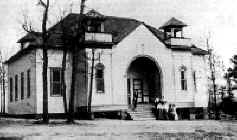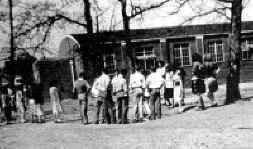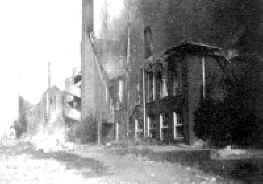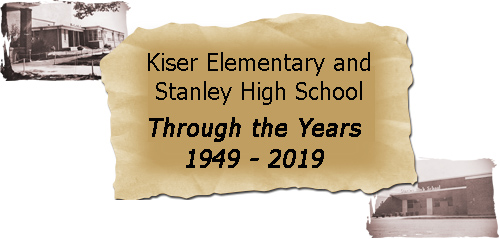


















|
The History of Stanley, North
Carolina
[ Back ] [ Next ]
Schools
 |
| Stanley Creek
Institute. Begun by the Methodist Conference in November 1900

|
Preliminary History of Stanley Schools
By: Alfred
Rhyne and Joyce Handsel
Stanley, North Carolina, as we know it today, was once called Brevard Station. It was named in honor of
Colonel Alexander Brevard who originally owned the land upon which the first city school and first churches
were built. A railroad was built and the village was laid out on each side of the railroad.
At that time in history, schools in this area were normally little one room buildings scattered around the
countryside. Usually there was only one teacher for all grades. School was held for only three or four months of
the year, and this was during the winter months when field work could not be done. In a few cases summer
sessions were held for about six weeks and only if a teacher and money was available. The county tax rate at that
time was so low that no money was available for schools, so each locality supported its own little school. This
was true of the schools in and around Brevard Station. Some of the first teachers were volunteers who themselves
had little schooling. Several preachers in the area held classes in church buildings.
One of the first school buildings in this area was thought to be in operation in the early 1850's. It was
located west of the settlement before it was named Brevard Station. It was a one room building constructed of
logs
and had no windows. The seats were made of wooden slabs. This area as we know it today is out Mauney
Road
near the Bob Rutledge Home Place (actually from Mauney Road onto Mayberry Road on the left. Mary
"Polly"
Rutledge Smith, wife of Alexander Smith, was probably the first teacher at the Rutledge
School.) A later Rutledge
school was located closer to Hoyles Creek on Hoyles Creek Road.
There was a school located down near the South Fork River between Dallas and Brevard Station. It was
called Hoyle School. It also was a one room building and had one teacher. The county later built a new structure
to replace the old one and painted it white, so it was then called the "White
School." A portion of the White
School is still standing today, 1992, behind Jacob Rhyne's home. Mr. Paul Rhyne (Jacob's father) has the old bell
that was used to call students to class. The grades ran from first through seventh. Students from Hoyle, Rhyne.
Jenkins, Suggs, Smith, Setzer, Boyd, Gates, Lineberger and other families attended school here. Two of the
teachers were Miss Sallie Brown and Mr. Ernest Lineberger.
 |
|
Five Forks School |
Another school known as the Five Forks School was
located east of town near the Stanley Creek. We know the
area as the intersection of Blacksnake Road and the Blaine
Cloninger or Upper Stanley Road. When this school was in
operation the Derr family lived nearby. In fact the road to
this area ran by the Morris farm, thence across Stanley
Creek, on up the hill past the E. L. Pegram home and by the
Derr home. There was at that time an intersection of five
roads, hence the name Five Forks for the school. In this
school Mr. Peter Stewart Ney was said to have taught here
for a while. Mr. Ney was a French Empire military Marshall
- affectionately known as "bravest of the brave" next to
Napoleon. After defeat of Napoleon, Ney was captured and
arrested for treason, sentenced to be put to death by firing
squad. He escaped and reportedly turned up in North Carolina employed as a teacher in various communities. Mrs.
Ida Abernethy and Miss Bernice Rankin also taught in this
school. The pioneer families of Derr, Abernethy, Smith,
Rutledge, Pegram, Carpenter, Armstrong, Eddlemen, Reinhardt, Benson, Rhyne, Clanton and Cloninger attended Five
Forks School.
There was another school called The Willis School. It was located west of Stanley on the Philadelphia
Church Road. This school served that area children until some of the consolidation took place.
Another school was located east of Alexis near the Mt. Zion Church and was called
Mt. Zion School.
Later a school was located in the village of Alexis. Children of the families of McClure, Hager,
Abernathy,
Henderson, Falls, Mendenhall, Oats, Patterson, Spencer, Robinson, Stowe, Detter, Torrence, Stroup and others
attended the Alexis Schools. It operated a number of years until consolidation of many small schools took place.
The Rankin Town School was located east of Stanley on which we know now as Old Highway #27, about
halfway to the town of Mt. Holly, just off Richard Rankin (Willowside Rd.) This school was taught by Miss
Bernice Rankin and others. A private school had been held for a while by the wife of
Col. Richard Rankin. She taught her own children and those of close neighbors.
She held classes in on old log kitchen building behind her home. There was another
Rankin School on Old Highway 27, for the children of black families in that area.
The Clemmertown School was located a couple of miles southeast of Stanley on the Hickory
Grove Road and corner of Spencer Mountain Road intersections. This was also a one room, one teacher
school. It was started in 1899 when Mr. Henry Albertus Clemmer and his wife, Mrs. Frances
Setzer Clemmer loaned enough land on Hickory Grove Road to build a public school for the area
known as Clemmer-town, just south of Stanley. The families of Clemmer, Harman,
Joy, Stroup, Hoffman, Smith, Lineberger, McKeown, Watts, Rhyne, Rankin and
Abernathy went to this school.
The Luckey School was built and started classes in 1907. It was a one room, white
framed structure. The school was located on the Alexis-Lucia Road near the old Carpenter home.
It was attended by children in that general area. Children who attended the
Luckey School were from the families of Alexander, Luckey, Sherrill, McLean,
Friday, Nixon, Pope, Finch, Huitt, Wallace, Hunter, Brooks, Craford, Sifford,
Dixon, Roseboro, Shipp, and Morrison. This school was one of the last small schools to be
consolidated into bigger schools sometime in the 1940's. This was a school for the black race as was
Springfield School which was on the South side of town. This school was started in the
Springfield Church. It was also closed when consolidation of schools began.
In 1900 the Methodist Conference had become educationally conscious and had decided to establish some
high schools in this area. Through the influence of Mr. W. C. Thompson, E. L. Pegram and Rev. W. B.
West, Sr. then the pastor of the local Methodist Church, our village was selected as a site for one of
these schools. Mr. Thompson and Mr. Pegram gave to the Conference the little triangular piece of
wooded land out in front of the present school building, for the school's use.
Mr. Steve Stewart, a 24 year old Trinity College (now Duke University) graduate and Miss Alice G.
Daniel, a graduate of the State Normal College, were asked to run the school. Mr. Stewart spent
the entire summer before school opened, traveling, mostly on foot, urging the people of this
community to start their children in school in September. Up until this time lots of boys and girls
had to help with the farm work and a good many from 10 years and older worked in the cotton mill.

| |
Stanley Creek Institute |
The new building, called Stanley Creek Institute, had two big rooms separated by folding doors, a
music room and two cloak rooms. A stage ran the entire length of the high school room so that it
could be used as an auditorium on special occasions. The tree stumps that were on the grounds and
big rocks were dug up and removed by boys who missed their spelling lessons or thumped the girls with
"spit wads." The Methodist Conference later sold or gave the school and property to the County and a public school
was established here.
In 1916 a six room brick building, two stories high was built. This new building was to replace the
old academy structure. As time went on four additional classrooms were added on the south side, a
few years later more rooms were built and by 1937 there was a total of 18 classrooms.
When the six room brick building was started they tore down the old frame building set up by the
Methodist Conference. This was a mistake because the new building was not completed in time for
school in the fall. Due to this fact, classes had to be held at different locations around town.

| |
Stanley School Gymnasium built around 1939.
Picture taken around 1950 |
The Depression Years of the Thirties was a very rough time for all concerned; improvements to schools
and teacher pay was very low. The "WPA" was set up by the government to help as many out of work
people as possible. A project around Stanley was to convert a swampy area across the road from the
school building into a ball field and playground.
Up until 1939 the Stanley School had no gymnasium for inside play. The basket ball court was (outside-dirt court) beside the high school building. It was rough, uneven and hard on shoes and body parts.
In 1939 a Gym was built across the road from the elementary school near the ballpark.

| |
A view of the burning Elementary School
|
On the 22nd of January 1947 the large brick elementary school caught fire and burned to the ground.
(This occurred while school was in session, but happily all the children and teachers were
evacuated safely.) Plans had to be made quickly for replacement classrooms. Some of the grades were
located in church classrooms so that toilets were available. Some classes were held in the gymnasium.
Beginning in the fall of 1947 all classes for students from the elementary school were held in the
hastily constructed wood buildings that were named Chicken Coops.
A new building to replace the burned building was begun as soon as plans and materials could be
provided. The new building was completed in 1949.
Preparations for A New School

| |
The new Stanley Graded and High School as it looked in 1949-50. (Front left
is the old High School building constructed in 1923) |
The old Thomas home on the lot recently purchased was torn down in order to make space for the
new building. It would contain 20 classrooms, an auditorium seating 800, modern cafeteria, supply rooms,
library, offices and central heating. When completed in the school year 1949-50 it was said to be one
of the nicest in the county. During the school year 1954-55 an addition of 8 classrooms was built
onto the schools' west wing.
The building that had been constructed in 1949 served as an elementary and high school until 1966. A
few years prior, around 1960, a new elementary school was built out on Hovis Road and in honor of the
long standing and highly respected principal was named O. L. Kiser Elementary School. Stanley's
black high school students attened school in Bessemer City.
In the beginning of the fall 1966 school year, integration began. The black and white high school
students went to school together at the Hovis Road School which had had changed it's name to
Stanley High School. Elementary students then moved to the school building on East College
Street and took the name Kiser Elementary with them. Black students who had previously attended
Springfield School Elementary were integrated into Kiser School. The Springfield Elementary
School was renovated and became a Junior High School.
View the following school annuals presentation:

The End of a High School in the Town of Stanley
In 1972 the Stanley and Mt. Holly High Schools were consolidated into one called
East Gaston High
School. At this time the Stanley Junior High School moved from Springfield School to the Hovis Road
School which is today the location of Stanley Middle School.
The old high school building (built in 1923), which in later years served as a primary school, was
torn down in 1972. Grades one through three then moved into the Springfield School building.

[ The Museum ] [ Contact Us ] [ Stanley History ] [ Photo Galleries ] [ Citizens ] [ Recollections ] [ Schools ] [ Churches ] [ Community ] [ Recent History ] [ Order the Books ] [ Topic Index ] [ Site Index ] [ Search ] [ Acknowledgments ] [ Related Links ] [ Guestbook ]
|
|









